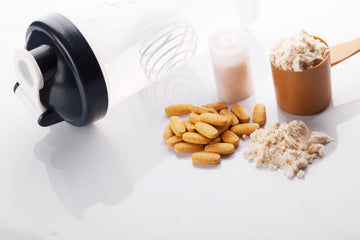Possibly you have ever wondered what amino acids are for and how useful they are as a supplement in training . As with many other products intended to boost physical performance, taking amino acids as supplements is associated with benefits, but its effects are multiplied when combined with a balanced diet.
If you want to improve your performance and overall health, you should learn more about these products and why amino acids are of such interest as gym supplements.
What are amino acids
Amino acids are the main component of proteins, their basic sustenance . In fact, this nutrient is nothing more than chains of amino acids intertwined with each other. There are 20 amino acids that are classified as essential and non-essential and thousands of proteins can be formed with them.
The essential amino acids are those that cannot be synthesized by the organism , so that it is necessary to go to the diet or to the sports supplementation to obtain them. The rest are the so-called non-essentials and the body is capable of producing them by itself, in its internal metabolic functions.
Beyond their function as generators of long peptide chains that give rise to proteins, amino acids are precursors of enzymes, neurotransmitters, and hormones . Its usefulness in the body for the execution of metabolic processes, goes beyond the question of merely sports and physical performance.
However, this time we focus on this plot: why it is good to take amino acids for the gym. On the other hand, it is important to point out that there are non-protein amino acids that are also part of metabolic processes.
What are they for and why are they good for your workouts?
The intake of amino acids in the form of supplements is a very popular trend among lovers of fitness , crossfit and, in general, among many gym users. And it is because this trend is associated with very positive results. In fact , it is very difficult to improve sports performance by going only to a diet rich in protein .
The amino acid deficit can generate a high feeling of fatigue, low defenses, longer recovery time and low level of muscle volume . In contrast, we can say that a good sports supplementation plan with these molecules helps to achieve the opposite effects.
If only diet is used to improve sports performance, it is usual to design plans that incorporate at least 15% protein of vegetable and animal origin . The latter are the richest in proteins of high biological value. However, the body uses amino acids as a secondary nutrient, after carbohydrates and fats, in the processes of muscle contraction, and this leads to the implementation of amino acid intake in the form of supplements in exercise routines.
Is it good to take amino acids for the gym? Which ones are the best?
The amino acids that are ingested externally through diet or sports supplementation are eight, the essential ones. Isoleucine, lysine, methionine, phenylalanine, threonine, tryptophan, and valine are their names.
All of them have important functions in the body, but they are not equally effective in improving sports performance. In this section, it is necessary to specifically mention the BCAA amino acids , a group that includes leucine, isoleucine and valine.
BCAAs are named after the acronym “Branched Chain Amino Acids”. They are especially interesting in improving training because they are directly incorporated into the blood, delay muscle fatigue and protect the body from loss of muscle mass.
L-glutamine is added to the BCAAs, which is highly recommended in episodes of muscle regeneration. This amino acid stimulates the storage of glycogen in the muscles and activates the production of proteins. L-carnitine , for its part, has a powerful fat-burning effect, it changes fat for energy. Its most verifiable effect is its use as an energy substrate, which affects the loss of adipose tissue.
L-arginine is an amino acid considered semi-essential, which means that it can be produced by the body but only in very small amounts. Therefore, in moments of muscle toning and growth, the intake of this amino acid helps to obtain better blood circulation, a vasodilator effect and with it a more fluid transport of nutrients and oxygen in the muscles.
When is it better to take amino acids?
The question about when is the best time to take amino acids is present in many fitness enthusiasts. Leaving aside this issue, which we will go into in detail below, it is necessary to know one point: to gain muscle and strength , the body needs a sufficient amount of amino acids in the bloodstream.
Turning to amino acids as a sports supplement is a perfect formula to achieve this goal, as long as a controlled intake is carried out. BCAAs, branched-chain amino acids, are the most recommended, and are sometimes reinforced with others such as glutamine, as is the case with our product BCAA Glutamine – Flavored powdered amino acids .
What are amino acids used for before training?
The option of taking amino acids before training is designed for athletes who seek muscle definition and complement these intakes with a caloric restriction diet. Also, exercise sessions should be very intense and long—at least 60 minutes—to improve muscular endurance. On the other hand, it is especially useful to take amino acids before training in case the sessions are first thing in the morning , on an empty stomach.
Take amino acids after training
A second option is to resort to these supplements once the training has finished. This alternative is the one followed by many bodybuilders and strength athletes who focus their sessions on increasing muscle mass.
Another group of athletes who can opt for this formula are endurance athletes, since the amino acids help to delay the appearance of stiffness when preparing long training sessions. In this case, the intake of amino acids after training leads to faster muscle recovery.
Is amino acid intake advisable before and after training?
This possibility integrates the advantages of the previous cases: before and after training, but it is only recommended in those situations in which another sports supplement is not used . The immediate effect is to protect the muscle during training, prevent fatigue and accelerate recovery and protein synthesis.
A variant is to take amino acids during training , which can be very useful if they are quickly assimilated supplements, as they help to perform better in the session and reach the end of it with enough energy.
Is it good to take amino acids before going to sleep?
Finally, there are some situations in which it is advisable to ingest amino acids before going to sleep. This happens, for example, when you are immersed in an extreme competition diet or face continuous double training sessions with very physical exercises . In these cases, amino acids enhance muscle recovery and even lead to better sleep.
In any case, amino acids for training are only useful if they are ingested in a controlled manner, following the manufacturer's instructions and the advice of sports nutrition specialists.
How are amino acids taken?
Amino acids come in capsule or powder format , but in both situations they must be taken with plenty of fluids . It does not matter if it is juice, water or sports drinks, but it is advisable not to do it with fat-content drinks, then whole milk is excluded.
Fat slows down the absorption of these nutrients, and the objective is just the opposite, that they pass directly into the bloodstream to carry out metabolic functions. In case they are taken as a post-workout solution, they can be combined with other supplements, for example, high-quality proteins.
Amino acids, especially BCAAs (high branched chain), dissolve in drinks of all kinds. In his choice it is usual to find formulas of the type 2:1:1; 4:1:1 ; and successive This refers to the ratio of leucine, isoleucine and valine.
BCAA preparations that follow the 2:1:1 formula are the ones that best adapt to the general needs of the body, but if you are looking to reinforce the properties of leucine, for example, you can opt for 4:1:1 or similar preparations. .
Beyond BCAAs, we find other options on the market, as we see in Scenit Nutrition. Some of them include branched chain amino acids supplemented with other nutrients , but others are directly more complete, with essential and non-essential and also reinforced with glutamine .
What are the effects of amino acids on your body
All amino acids are important for the body, but in this section we focus exclusively on the essential ones, those that must be incorporated into the body externally.
Isoleucine
This amino acid is present in foods such as chicken, peas, salmon, nuts, eggs, and whole wheat flour. Its function in the body is to regenerate muscle tissue and provide enough energy for strength training.
leucine
Leucine appears in the same foods as isoleucine, but its effects at the organic level are different. This amino acid contributes to the development and maintenance of muscle protein , as well as providing energy to the muscles.
lysine
Pumpkin seeds and tofu are foods that add to the above list. Lysine, together with methionine , synthesizes carnitine , an essential compound in lipid metabolism.
methionine
Methionine, along with lysine, is a precursor to cysteine, a key amino acid for protein production . Some foods rich in methionine are salmon, beef, spinach, corn, or sesame seeds.
threonine
This amino acid is not as relevant in muscle growth, although it does help in the synthesis of isoleucine. In addition, it participates in the biosynthesis of vitamin B12 . Outside of sports supplements, we can find threonine in the same foods mentioned so far.
tryptophan
Tryptophan is another amino acid that does not have important positive effects at the muscular level. Its function in the body is to act as a precursor of serotonin, the well-being hormone . We find tryptophan in soybeans, cocoa, cashews, and chicken.
Valine
Valine is, along with leucine and isoleucine, the third high branched chain amino acid. Its presence in the body provides energy to muscle cells . This compound appears in cheese, whole wheat flour, chicken, spirulina, and peas, among other foods.
phenylalanine
Phenylalanine is involved in the production of proteins and hormones: adrenaline, dopamine and noradrenaline . Some foods rich in this amino acid are salmon, eggs, poultry and pork, or nuts such as walnuts.
Benefits of amino acids for sports
Amino acids, under normal conditions, do not intervene in total energy expenditure, since for this purpose carbohydrates are in the first place and later fats, which act as an energy reserve.
But it happens that in long-term aerobic sports or in high-intensity training sessions on specific muscle groups, glycogen stores drop to worrying levels, and that's when muscle proteins have to be used.
In these scenarios it is good to take amino acids for the gym, as they help to obtain the necessary energy and the result is gain and recovery of muscle mass, improvement of the immune system and reduction of muscle fatigue.
There are recent studies in athletes that show that a controlled intake of high branched chain amino acids also translates into shorter muscle recovery periods.
Amino acids and their effects on training are enhanced when a balanced and complete diet is followed, adapted to the level of training and metabolic needs of each athlete, assuming that supplementation is a complement, never a substitute.
If you have come this far, you already know what amino acids are for and why their use in sports supplementation is so popular. One last piece of advice is to enter them responsibly, with good professional advice and following the manufacturer's instructions.





